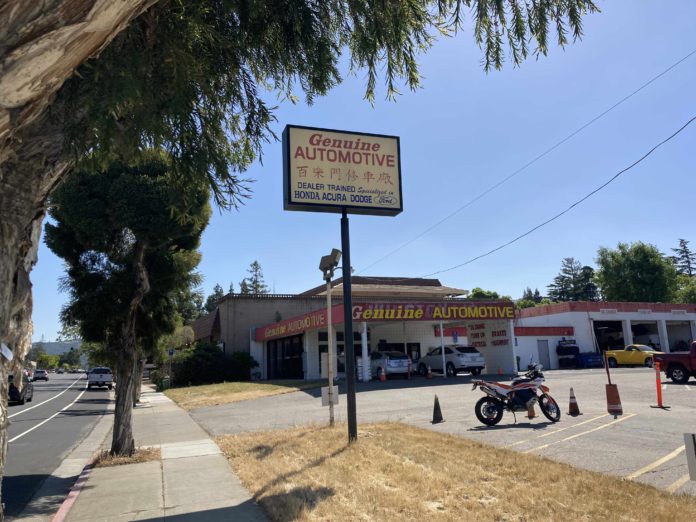
As the Los Gatos Green project arrived for a hearing at Planning Commission April 23, it began to test Los Gatos’ ability to wheel-and-deal its way towards less development, in an environment where it doesn’t hold many cards.
City Ventures has proposed 55 multifamily units, including four live-work units and eight lower-income units. The plan includes a mix of studio, two- and three-bedroom units. And the height falls within Los Gatos’ maximum of 45 feet for the Housing Element Overlay Zone, in which the property at 15349-15367 Los Gatos Blvd. is situated.
That’s where Genuine Automotive currently operates.
Though the atmosphere was cordial, there was a clash of ideology at play.
It pitted longtime suburban Silicon Valley commuters against a younger generation that often sees the addition to car culture as a vestige of Boomer folly.
Exhibit A was Commissioner Rob Stump, the man who bragged while running unsuccessfully for Council he once counted the “Mighty Moss” gas power plant (in Moss Landing) as part of his facility portfolio while a PG&E executive.
He made it clear that he doesn’t believe the young people and families targeted by these units will choose to reduce their reliance on vehicles—at least not to the extent the developer claims.
On this point he faced off not against a fiery evangelist for New Urbanism, but a friendly and cooperative developer rep with a buoyant tone reminiscent of the most recent lineup of female iHeartRadio podcast hosts: City Ventures Vice President Pamela Salas Nieting.
“I’ve gotta believe that there’s gonna be overflow. What have you seen in your other developments, and where does that overflow go?” Stump said. “I know the answer is, It depends. But I’m just interested.”
“I have a better answer than depends,” she said, watching as Stump’s neutral expression blossomed into a warm, toothy grin. “There’s a reason why City Ventures always chooses sites in infill developments close to transit, is because our units…they’re between 300 and 1,500 square feet—they’re intentionally made small.”
Similar to the trend promoted by the nonprofit Casita Coalition of “affordability by design,” this project has embraced “parking by design,” she said.
“Yours Truly used to live in the city in a 700-square-foot apartment with two babies, and we walked everywhere and took transit,” she said, clearly leaning on her own experience as a Walnut Creek Planning Commissioner. “So, I’ve seen it work with a certain generation—and, particularly when you’re offering those size units, and when you’re offering that accessibility also to transit.”
Exhibit B? Bewilderment around how adding 55 units could be deemed to not create big traffic impacts.
This is where a move in environmental planning circles (away from looking at how congested intersections will get, towards the overall number of car trips generated or eliminated by a project) was highlighted.
“We always looked at Level of Service, which is intersection congestion,” said Joel Paulson, Los Gatos’ community development director, meaning in regards to California Environmental Quality Act reviews. “State law changed, and from a CEQA perspective, they moved to the Vehicle Miles Travelled.”
However, Paulson said, the Town still does take Level of Service into account to some extent.
Los Gatos Senior Traffic Engineer Mike Vroman said live-work units reduce the number of theoretical driving trips.
“There’s no VMT impact, because this project is consistent with the General Plan and the Housing Element,” he said. Chair Steve Raspe said he was pleased the developer didn’t try to build to the maximum.
“I think our town needs more housing, more affordable housing products,” he said. “We can argue about what that looks like, and how many units are going to be in there, but I think this is an excellent location for this type of product.”
He called the aesthetics “appealing,” adding he wasn’t a fan of the suggestion, from Commissioner Susan Burnett, that each unit get a unique facade. That might make the town look more like New York City, not less, he suggested.
At first, commissioners seemed inclined to force the developer to return after a redesign.
But when staff reminded them the project, due to new State laws about SB 330 projects, must be dealt with in five meetings total or it gets approved automatically (and this was already technically the second hearing), even Stump and Burnett began to see the merits of moving things along.
Meanwhile, the developer rep—perhaps tapping into her experience as chair of the Builders Industry Association’s Housing Legislation Committee—began to request a continuance.
If this was granted (and the project recommended at the next meeting), it would leave Council with just two hearings to deal with the project before it gets deemed approved, by-right.
In the end—after an amendment was added to force the developer to work with the Town Architect to make some minor revisions—Planning Commission voted 4-0 in favor of a motion to recommend the project (with Kendra Burch and Emily Thomas absent, though they live close enough they’re supposed to recuse themselves anyways; staff noted the new commissioner, Joseph Sordi, will be joining the the body shortly).









